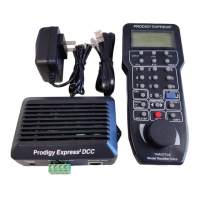Page: 9
Deceleration Rate (dEc): This rate simulates the drag of a heavy load as the loco slows
down so when you decrease the speed setting, the loco will gradually decrease its speed.
PROGRAMMING LOCO ON THE PROGRAM TRACK
1. Make sure your Cab is allowed to program on the Program Track.
2. Place the loco on the Program Track. Press PROG to select “Prog Prog Track”. Press
ENTER.
3. First, “Adr” will ash, prompting you to program the loco address. Using 0 - 9, enter
the loco address followed by ENTER, or press ENTER to skip.
NOTE: For the beginner or if you want to only program the loco address, you can stop
right here. Put the loco back on the Main Track. Select the loco by pressing LOCO then
enter the loco address and press ENTER. Now you can run the loco. The Program
Track is strictly for programming and reading decoders. Locos will not run on the
program track.
4. Next, “SV” will ash, prompting you to program the Start Voltage. Input data and then
press ENTER.
5. Next, “Acc” will ash, prompting you to program the acceleration rate. Input data and
then press ENTER.
6. Next, “dEc” will ash, prompting you to program the deceleration rate. Input data and
then press ENTER.
7. Next, “TV” will ash, prompting you to program the Top Voltage. Input data then press
ENTER.
8. Finally, “CV#” will ash, prompting you to program a CV (Conguration Variable). At
this point, you have already nished most of the decoder programming. You can stop
programming here by pressing ENTER.
9. If you want to program a CV, enter a CV number. Press ENTER. Then enter CV data.
Press ENTER. “CV#” will ash again, prompting you to program another CV. To skip,
press ENTER.
NOTE: Programming a CV with incorrect data can cause a decoder malfunction. Read
Variables section.
PROGRAMMING LOCOS ON THE MAIN TRACK
Programming on the Main Track can save you the eort of moving a loco to the Program
Track for programming. However, you have to know the loco address in order to program
on the Main Track. Otherwise you have to program the loco on the Program Track. Not
all decoders support the Program on Main feature. Please read your decoder’s manual to
check whether the decoder supports this feature.
1. Make sure your Cab is allowed to program on the Main Track
2. To program on the Main Track, press PROG to select “Prog Main Track”. Press
ENTER. The current loco address will ash, prompting you to program the current
loco.
3. To program the current loco, press ENTER; to program another loco, enter its address
and press ENTER.
4. The rest of the programming procedures are the same as the Programming on
Program Track procedures (see above). We recommend you bring the loco to a
stop before programming because if the moving loco has a bad pickup, it may fail to
receive the program command, causing a malfunction.

